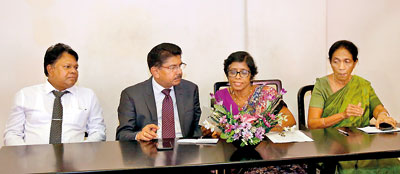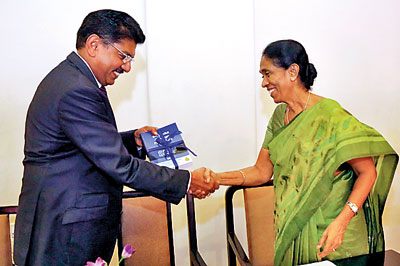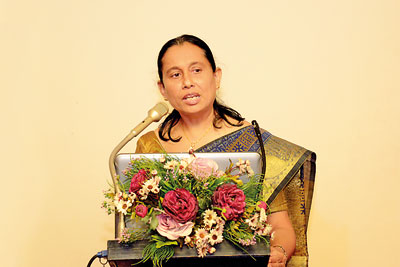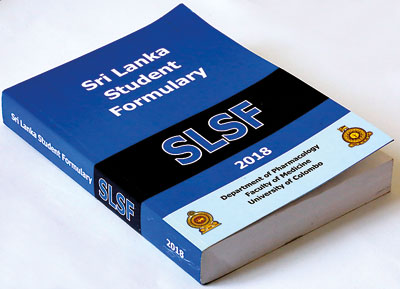News
First-ever Students’ Formulary from Colombo Med Fac
Poisons and medications! They are one and the same, with only one major difference – poisons become medications only with proper prescribing and rational use. To aid proper prescribing and rational use, a team at the Department of Pharmacology of the Colombo Medical Faculty, in a first in the country and most probably in all of Asia as well, has come up with The Sri Lanka Students’ Formulary (SLSF).

At the head-table (from the left) Dr. Lal Panapitiya, Dr. Anil Jasinghe, Prof. Jennifer Perera and Prof. Kusum de Abrew
It was at a simple ceremony in the Boardroom of the hallowed Colombo Medical Faculty amidst a distinguished gathering that the birth of the SLSF, after a hard labour of about eight years, was witnessed on July 30. Those at the head-table were the Director-General of Health Services, Dr. Anil Jasinghe; the Director of the Medical Supplies Division (MSD), Dr. Lal Panapitiya; the Dean of the Colombo Medical Faculty, Prof. Jennifer Perera; and Professor in Pharmacology, Prof. Kusum de Abrew, while in the audience were the Emeritus Professor in Pharmacology, Prof. Laal Jayakody and the former Professor of Pharmacology, Prof. Krishantha Weerasuriya.
Hailing it a red-letter day, Prof. Perera commended the Colombo Medical Faculty’s Department of Pharmacology, involving both academic and non-academic staff, for launching such an important initiative.
Comprising “exhaustive” information, she said it was a “uniquely’ Sri Lankan publication, as much research has gone into what should be included in it. It is not copied from other formularies, but is based on “evidence of our use of drugs”.
“You made it possible,” said Prof. Perera, adding that it will help ensure the safety of patients by preventing medication errors as the SLSF will give guidance on appropriate prescribing.

Prof. Kusum de Abrew presents the SLSF to Dr. Anil Jasinghe
Pointing out that studies have indicated that when new interns take over, there is an increase of morbidity (illness) and mortality (death) among patients, she reiterated that the SLSF will help reduce medication errors.
Prof. Perera urged that a follow-up should be conducted once the SLSF is in use to show its benefits to the world. It should also be reviewed, with the feedback, both positive and negative, being included. There should be future editions, adding on new drugs and their side-effects etc., or at least, the SLSF should be edited and updated at least once in three years.
The Head of the Department of Pharmacology of the Colombo Medical Faculty, Prof. Shalini Sri Ranganathan reiterated that there are no safe medications only safe prescriptions.
“We (medical faculties) create the doctors who then work in the Health Department,” she said, pointing out that there is a lot of irrational prescribing. She urged the Director-General of Health Services to set in motion an internal audit system to curb this.
“All drugs are poisons. It is the dosage which makes the difference – between a poison and a medication,” Prof. Sri Ranganathan stressed. Requesting students to use the SLSF, Prof. Laal Jayakody said that it is a first in this part of the world. “We need to catch the students young and ingrain in them rational prescribing,” he said, adding that it is not just a formulary but also comprises pharmacokinetics and pharmacodynamics.
The President of the Medical Faculty Students’ Union, Damitha Liyanaarachchi also spoke.
| Going through the pages of the Students’ Formulary Underscoring that producing the Sri Lanka Students’ Formulary (SLSF) was “no easy task”, Specialist Physician and Professor in Pharmacology, Prof. Priyadarshani Galappatthy took the audience through the book, explaining in meticulous detail what it is all about.  Prof. Priyadarshani Galappatthy takes the audience through the pages of the SLSF (Pic courtesy of the Medical Faculty) What is a ‘Student Formulary’, she asked, replying that it consists of a core list of commonly-used drugs that are prescribed by junior doctors, typically about 100 drugs. A limited formulary offers students a learning target that is “realistic and attainable”. These student formularies are a component of the core curriculum in clinical pharmacology by the British Pharmacological Society (BPS). A few countries and universities such as the Queen’s University in Belfast, Ireland and the Southampton University in the United Kingdom have produced them, while some have introduced electronic formularies. However, there are no records of any student formularies from Asia or the low/middle income countries, she said. Going back in time, she referred to the setting up of the Formulary Committee in 1957 which published the Ceylon Hospitals’ Formulary in 1959. This formulary is said to have been done single-handedly by Prof. Senaka Bibile. Then in 1994, the Sri Lanka Hospitals’ Formulary edited by Prof. Laal Jayakody came into use. Now, the Sri Lanka Student Formulary of 2018 has been published, a project initiated by Prof. Kusum de Abrew in 2010. “The SLSF is a source of reference of commonly prescribed medicines in the country and is meant for medical and other allied healthcare undergraduates as well as first contact doctors,” says Prof. Galappatthy, reiterating that it is to promote the rational use of medicines among junior prescribers and trainees. It will help promote the application of clinical pharmacology knowledge in clinical practice among junior prescribers. But that is not all – the SLSF is “different” to the usual formularies.
The SLSF Formulary Committee comprises Editors cum Contributing Authors Prof. Kusum de Abrew (Chairperson); Prof. Priyadarshani Galappatthy (Convener); Prof. Laal Jayakody, Dr. Chamari Weeraratne and Dr. Priyanga Ranasinghe. The other Contributing Authors are Dr. Sachith Abhayaratna, Dr. Piyusha Atapattu, Dr. Dinithi Fernando, Dr. Chiranthi Kongala Liyanage and Dr. Vipula Bataduwaarachchi. Secretarial assistance had been provided by Inoka Gammune. While the Health Ministry had provided the funding through the MSD, 5,000 copies have been printed by the Government Printer at a cost of Rs. 1.5 million. The SLSF is to be sold at cost to make the next print self-sustaining. | |


 The formulary includes details of about 300 individual drugs grouped into 19 sections ranging from anti-infective medicines to endocrine medicines; from anaesthetic medicines to medicines acting in the eye, ear, nose and throat; from immunologicals to immunosuppressants, to name a few.
The formulary includes details of about 300 individual drugs grouped into 19 sections ranging from anti-infective medicines to endocrine medicines; from anaesthetic medicines to medicines acting in the eye, ear, nose and throat; from immunologicals to immunosuppressants, to name a few.